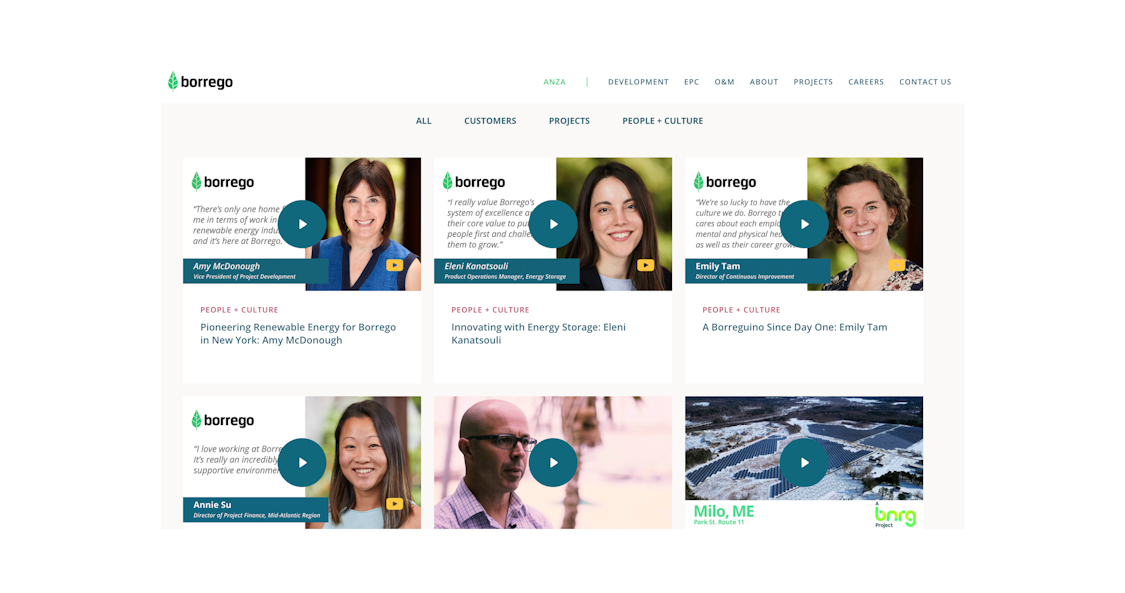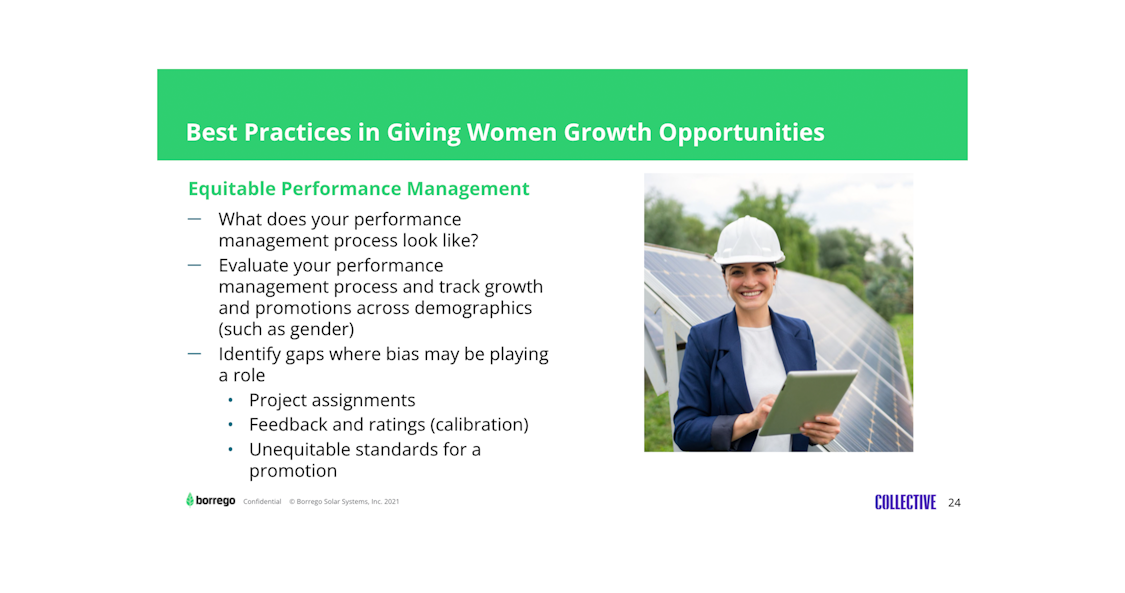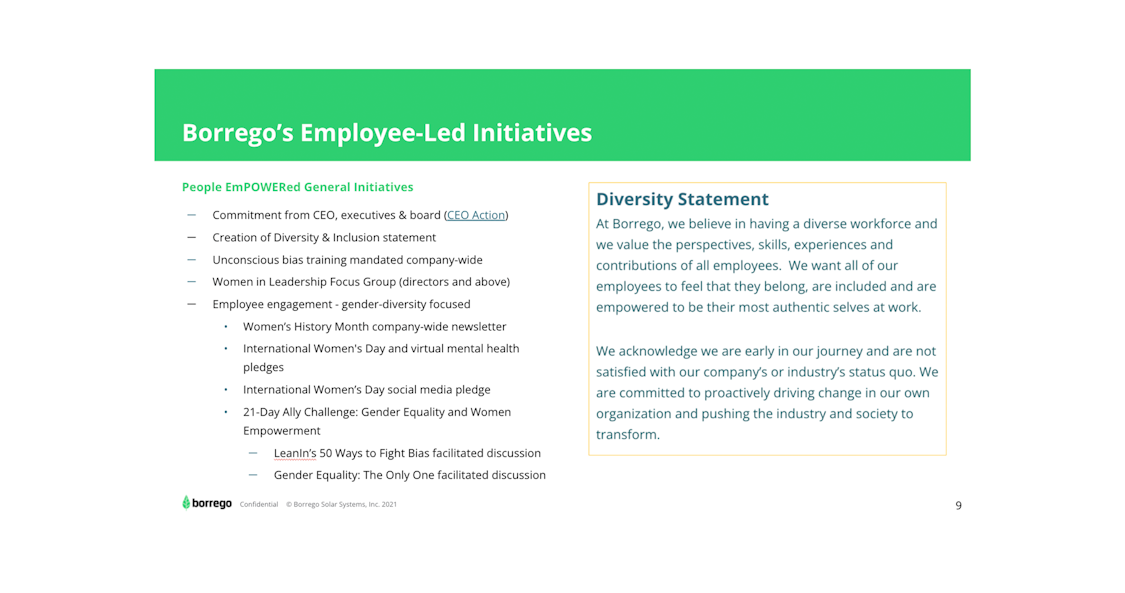
NOVEMBER 18, 2021
Cultivating Gender Diversity in the Solar Workforce
Based on attendance at our recent “Talent Talk” webinar focused on recruiting and retaining women in renewable energy, it’s clear that business leaders and employees are eager to take action to improve gender diversity in the industry. What came out of our discussion was a comprehensive list of the top priorities and tactics business leaders can follow when building out a DEI plan.
The webinar brought together the collective expertise of Kristan Kirsh, vice president of global marketing for Nextracker, Collective senior DEI strategist Patty Alvarenga, Borrego’s Nicolette Rizzo and Kenya Ansah, along with my own perspective as Borrego’s Director of Talent. Together, we discussed best practices, with real-world examples of strategies & initiatives for recruiting, engaging, and retaining women in solar, storage, and clean energy. (Want to watch the webinar replay? Click here.)
Whether your company is starting at square one, is in the process of creating a plan, or already has initiatives in play, we’ve pulled together this list of 5 critical strategies and (below that) a list of tactics for bringing diversity, equity, and inclusion into your organization’s internal processes and recruiting efforts.
5 Key Strategies for Cultivating DEI in Solar
- Hire Based on Concrete Competencies – Not ‘Culture Fit’
- Reflect on What Your Brand Says to Prospective Hires
- Increase Objectivity in Performance Management
- Create Mentorship Opportunities
- Foster a Culture of Psychological Safety at Work
First, let’s Start with the Statistics
It’s no secret that women are under-represented in solar and clean energy in general – it’s a fact we are confronted with year after year and something we at Borrego work to improve in our own organization. But recent statistics demonstrate an industry longing for change.
According to data from the National Solar Jobs Census 2020, solar grew more diverse last year – a great improvement, but only the first step in the long journey to creating a more equitable and inclusive workforce. Women in solar grew from 26% to 30% of the workforce year over year, and while the solar industry lost workers overall during 2020, the number of women employed increased by nearly 4,800 to over 69,000.
1. Hire Based on Competencies – Not ‘Culture Fit’
Bias can show up at every step of the hiring process – from scoping positions to the actual interview. When we begin the process of hiring for a role, it’s easy to imagine the exact person you would want to fill it with. We conjure up an “ideal” candidate – someone with certain skills or characteristics. Even in doing this simple mental exercise, we can significantly narrow the pool of candidates and exclude certain demographics. For that reason, those in hiring roles must create an equitable and structured process to mitigate bias so that candidates are evaluated fairly.
2. Reflect on What Your Brand Says to Prospective Hires
How your company showcases its DEI plan is crucial to attracting top talent and motivating them to check out your job listings. Consider if, and how, your organization is actively generating awareness around its DEI policies and efforts. Is that work visible to candidates interested in working for your company?
When candidates are searching for jobs, they want to work somewhere that will respect them and bring value and growth to their life. Demonstrating your company’s diversity and efforts to increase it may make potential job applicants more comfortable envisioning themselves working for your organization.
3. Increase Objectivity in Performance Management
Just like hiring and recruiting, performance management also requires a structured process with non-negotiable benchmarks. Often, data can play a crucial role in better understanding areas of weakness in performance management. If you track career growth at your organization and break it down by gender and race, you may find significant gaps where bias may play a role. Once you’ve identified potential pitfalls based on your company’s data, you can then use that to introduce structure and help eliminate bias and increase objectivity.
Here are some questions to ask when evaluating the fairness of performance management at your organization:
- How do you decide when an employee is ready for a promotion?
- Who gets promoted in your organization the most?
- How and to whom are sought-after projects assigned?
- How is feedback delivered to employees?
- Does your organization have clear and fair standards for promotion? If, so, what are they, and how are they applied?
- How accessible are those standards to employees? Do employees understand them and know where to go with questions?
- Is your performance management process practiced with consistency and structure?
4. Create Mentorship Opportunities
Another key area where women often lack resources, especially in the renewable energy industry, is in access to mentorship — from other women as well as male leaders. According to SEIA’s 2019 survey, 20% of women responded that they have not been successful in moving up the career ladder compared to only 7% of men. Having a strong mentor relationship can play a key role in helping employees climb the career ladder, move into leadership positions, and stick around for long-term growth at a company.
5. Foster a Culture of Psychological Safety at Work
Psychological safety in the workplace is about how comfortable employees feel speaking up and admitting mistakes. It’s about removing fear from the workplace culture and shifting focus toward learning and growth. And it’s a key component of an inclusive workplace that empowers employees to contribute their own valuable, unique insights.
Cultivating psychological safety is about growing a relationship of trust with employees in your organization. The core skill here: listening. Everyone wants to be heard, and employees are also a lot more likely to stick around when there is mutual trust.
Tactics for Implementing your Diversity, Equity, and Inclusion Plan
There isn’t a one-size-fits-all solution to embedding diversity, equity and inclusion practices into an organization. Here are some of the best ideas and resources shared by Borrego, Nextracker, and Collective in the webinar.
Overcoming Bias in Recruiting
- When writing job descriptions, establish what skills are actually necessary to succeed in the role without including all the “nice to haves.”
- Anonymously review the candidate pool.
- When interviewing candidates, select a set of core competencies by which to evaluate all candidates to prevent moving goalposts during the evaluation process.
- Avoid hiring someone or not hiring someone based on “culture fit” – this is often grounded in bias.
- Leverage data and solar recruiting metrics as you incorporate DEI practices into recruiting and hiring to track the success of your process and fix what’s not working.
- Include female-identifying colleagues on interview panels.
- Explore external resources like SEIA’s Diversity, Equity, Inclusion and Justice Certification Program, Paradigm’s extensive library of DEI education materials and Renewables Forward’s DEI Playbook Parts I and II.
- Hire a third-party DEI consultant like Collective to assess your organization’s DEI needs.
Improving DEI Visibility in Your Recruiting
- Download and use this “10 Things List for Diversity Recruiting” template that Borrego uses in their recruiting. Use this list to make a list of specific actions you can take to attract female-identifying candidates to your open position.
- Write and include a diversity statement on your website and in your job listings.
- Make benefits like family leave visible in job posts to demonstrate your investment in employee wellness.
- Feature women employees’ perspectives and presence on your website.
- Network with organizations that support industry DEI efforts, such as Women of Renewable Industries and Sustainable Energy (WRISE) and Women in Cleantech and Sustainability, to expand the demographic reach of your job listings.
Increasing Objectivity in Employee Performance Reviews
- Assess compensation equity by gender and race to identify gaps.
- Establish publicized career paths and development opportunities.
- Provide access to organization-wide unconscious bias and DEI training.
Improving Access to Career Guidance & Mentors
- Create space within the organization for employees to form internal employee resource groups for networking and organizing, such as Borrego’s AC WATT (A Collective of Women Across the Team.)
- Sponsor growth opportunities for women in cleantech, similar to Nextracker’s three-year Half the Sun Scholarship program in partnership with Solar Energy International.
Cultivating visibility for women in the industry
- Encourage speaking opportunities and other expert-led discussions to give women in solar more share of voice on the typical industry “manels.”
- Broaden the list of who represents your company at industry events and trade shows.
Fostering Psychological Safety and Trust
- Celebrate awareness dates like Women’s History Month and International Women’s Day with newsletters or social media pledges.
- Conduct an annual DEI survey like Nextracker does, which often yields new feedback and valuable ideas.
- Create a steering committee, such as Borrego’s People EmPOWERed, to define the company’s DEI objectives and create a feedback medium between employees and executives.
- Cultivate opportunities for partnership with male colleagues and leaders to create champions and allies for their women colleagues.
At Borrego, we know that creating a diverse and inclusive industry is just as important as solving the world’s energy problems. The progress we’ve made so far is exciting, but we know there is plenty of work still to be done. We have a plan in action to improve our organization’s diversity, and that plan will continue to grow and evolve. Many of our fellow industry leaders do too. But it’s a complex process, and we’re eager to collaborate with our peers to share approaches that have worked well for us and keep our perspectives on this important topic fresh and in touch with the needs of the modern workforce.
We will continue to build momentum around and contribute to diversity, equity and inclusion efforts in our industry, and hope you’ll continue this conversation with your leadership and People & Culture teams. If you’d like to connect, can reach us at PeopleEmPOWERed@borregosolar.com.
Looking for a job in renewable energy, or know someone who is? We’re hiring!




